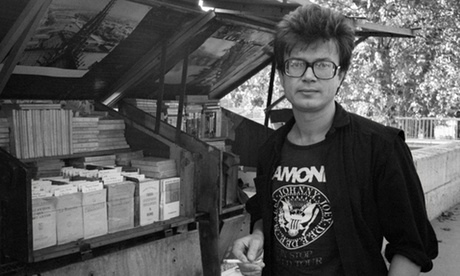If you’ve been watching Adam Curtis’s multi-part documentary I Can’t Get You Out Of My
(and if not, why not?) you may have been reminded, or minded for the first time, of
Eduard (sometimes Edward) Limonov.
He was a Russian poet, novelist, memoirist, newspaper editor, and a dissident, although his dissent was not of the standard anti-Soviet kind that went down so well in the United States, to which he moved in 1974. He was also a politician, though his politics were all over the place. He was (almost certainly unjustly) charged in Russia with terrorism and spent two years in jail. He also seemed to be – and this may have been the final nail in his political coffin - a pal of war criminal Radovan Karadzic (not a good look).
Limonov’s appearance in the Curtis film shows him with Karadzic, apparently firing a machine gun towards the besieged city of Sarajevo (an even worse look), though Limonov claimed he was a victim of creative editing, and was in fact just shooting at a target.
As a writer Limonov is probably best known for It’s Me, Eddie, a ‘fictional memoir’ about his life in New York in the mid to late 70s - hence the Ramones t-shirt below, I suppose (though I can't swear this is in New York)
Also, sometimes he did a Saturday Night Fever thing, which again is not a good look.
If the book’s to be believed he (and/or his fictional protagonist) did an awful lot of walking in New York, at a time when it wasn’t the safest city in the world, which is why he’s here in this blog.
He writes, “All I was doing was sitting, lying, smoking, drinking from a bottle in a paper bag, sleeping in the street. I would go two or three weeks bumming around New York on foot, sometimes walking two hundred and fifty blocks a day, bumming around in neighborhoods both dangerous and safe, without talking to anyone.”
There are about 20 blocks in a miles (depending on the block) so that’s about 12 and a half miles. Quite impressive. Then he upped his game.
“I once covered more than three hundred blocks in one day, on foot. Why? I was out for a walk. I generally go almost everywhere on foot. Out of my $278 a month I begrudge spending fifty cents to ride anywhere, especially since my sorties have no set destination, or the destination is indefinite. For example, a place to buy myself a notebook of a particular format. They don't have it at Woolworth's or at another Woolworth's or at Alexander's, and I march down to the sidewalk markets on Canal Street to scrounge up the right notebook. All other formats irritate me.
“I am very fond of tramping around. Really, without exaggeration, I probably walk more than anybody else in New York. Unless there's some tramp who walks more than I do, but I doubt it. So far as I can see, bums are all immobile, more apt to lie still or putter sluggishly about in their rags.”
There’s a lot of this in the book, also a certain amount of talk about ‘pederasty’ – he was in favour of it.
For some of his time in New York he lived in the Winslow Hotel on 55thStreet and Madison Avenue. In 1982 the building was turned into an office block, with shops on the ground floor. One of the shops, at least before Covid, was The Walking Company, just a shoe shop, but for some of us a reminder of the walking contradiction that was Eduard Limonov.

























